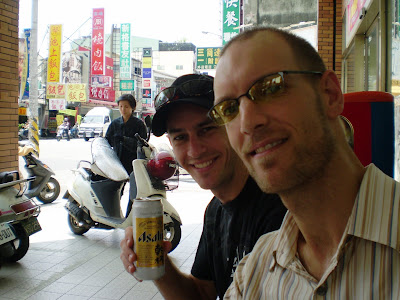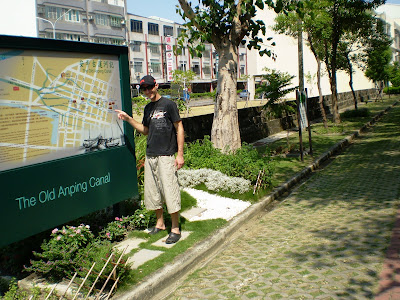 After procuring a bike for Jamie we met up with Andrea on her bike and our first stop was... another CPC petrol station. This time Jamie hung out while Andrea and I pumped our tyres up. Jamie took this shot of us and our bikes. We bought our bikes not long after we moved to Taiwan. I managed to get a bike with an extra-large frame, a difficult assignment here in Taiwan. At one of the many bike shops we enquired at, the manager offered to build a bike for me using a combination of new and used parts. He happened to have a few extra large bike frames somewhere that he couldn't sell and I guess I was a prime candidate buyer. The bike is a lot better than the one I have at home so I will be taking it with me wherever I go next.
After procuring a bike for Jamie we met up with Andrea on her bike and our first stop was... another CPC petrol station. This time Jamie hung out while Andrea and I pumped our tyres up. Jamie took this shot of us and our bikes. We bought our bikes not long after we moved to Taiwan. I managed to get a bike with an extra-large frame, a difficult assignment here in Taiwan. At one of the many bike shops we enquired at, the manager offered to build a bike for me using a combination of new and used parts. He happened to have a few extra large bike frames somewhere that he couldn't sell and I guess I was a prime candidate buyer. The bike is a lot better than the one I have at home so I will be taking it with me wherever I go next. When our collective tyres were all inflated to their recommended pressure in pounds per square inch we rode a few blocks to the west and came to the Eternal Golden Castle, also known as the Uhrkuenni Battery. According to the great sage Wiki, Eternal Golden Castle:
When our collective tyres were all inflated to their recommended pressure in pounds per square inch we rode a few blocks to the west and came to the Eternal Golden Castle, also known as the Uhrkuenni Battery. According to the great sage Wiki, Eternal Golden Castle:is a defensive castle in Anping, Tainan, Taiwan. The castle was built in 1874 by the famous Qing official Shen Baozhen in order to safeguard the coast and to defend the island against Japanese invasions.In 1895, when Taiwan was invaded by Japan, the Taiwanese people fought against the Japanese battleship from this fortress. During the Russo-Japanese War, the Japanese government sold some of the fort's cannons in order to help pay for the war. With its cannons gone or obsolete, the fortress lost its military value.
As you can see in the photo, after being approached and greeted by Andrea, the little boy in the yellow shirt is running to tell his mum that a tall foreign girl with long, blonde hair said hello to him and that she looks just like Uma Thurman from the movie he watched with his dad on TV last night.
 There are plenty of plaques in English about the fort about the fort (intentional and correct repetition). Apparently this one is a bastion-style artillery fort. It's still hard to realise that people died protecting this place from assault, especially when you're surrounded by merry-making tourists with icecreams and fizzy drinks.
There are plenty of plaques in English about the fort about the fort (intentional and correct repetition). Apparently this one is a bastion-style artillery fort. It's still hard to realise that people died protecting this place from assault, especially when you're surrounded by merry-making tourists with icecreams and fizzy drinks. One of the fort's cannons (or cannon; which is plural?). This one is a replica of the original.
One of the fort's cannons (or cannon; which is plural?). This one is a replica of the original. Later that day we made our way to the local beach where we were joined by some friends of ours. We enjoyed the end of the daylight hours, tossing the frisbee around and generally enjoying being at the beach. In this shot, John and I are setting up an extremely cunning and convincing optical illusion shot in which it will appear that I am holding a miniature sun between the tips of my fingers at arms length. So clever!
Later that day we made our way to the local beach where we were joined by some friends of ours. We enjoyed the end of the daylight hours, tossing the frisbee around and generally enjoying being at the beach. In this shot, John and I are setting up an extremely cunning and convincing optical illusion shot in which it will appear that I am holding a miniature sun between the tips of my fingers at arms length. So clever! When the last of the light had faded it was time to enjoy barbecued comestibles (edible things). A great feasting was had and a great dinner was eaten by all. The star chef of the evening was the admirable and worthy Andrea Catherine Crowe, barbecue chef extraordinaire, cute culinarian, and heavy heater (sounds like heavy hitter). I think we brought the vegetable kebabs to this one, just like the last one and the one before that.
When the last of the light had faded it was time to enjoy barbecued comestibles (edible things). A great feasting was had and a great dinner was eaten by all. The star chef of the evening was the admirable and worthy Andrea Catherine Crowe, barbecue chef extraordinaire, cute culinarian, and heavy heater (sounds like heavy hitter). I think we brought the vegetable kebabs to this one, just like the last one and the one before that. You know that look on a dog's face when you drop a big bowl of a special treat in front of him? Well I am that dog and Andrea has just dropped a chocolate birthday cake down in front of me. I'm sure she made me promise to be a good boy before allowing me to get my little paws on it. It was actually a week or two after my birthday but we hadn't gotten around to doing anything about it so Andrea got a cake so that we could make a mention of it while everyone was around.
You know that look on a dog's face when you drop a big bowl of a special treat in front of him? Well I am that dog and Andrea has just dropped a chocolate birthday cake down in front of me. I'm sure she made me promise to be a good boy before allowing me to get my little paws on it. It was actually a week or two after my birthday but we hadn't gotten around to doing anything about it so Andrea got a cake so that we could make a mention of it while everyone was around. This photo represents the last photo taken while Jamie was in Tainan. Jamie took the photo with his camera. Here you see us standing on the street around the corner from our apartment building. We have just eaten breakfast at the adjacent Laguardia breakfast restaurant and I am calling our friend Craig to take him up on his offer of meeting up for coffee. Not long after this I am downloading the photos from Jamie's camera onto Andrea's laptop. On the morning of the next day, Jamie will pack his bags and we will be driven to the HSR station by a demonic taxi driver and then catch the HSR train up to Taipei to spend a couple of nights before Jamie boards his plane for other lands.
This photo represents the last photo taken while Jamie was in Tainan. Jamie took the photo with his camera. Here you see us standing on the street around the corner from our apartment building. We have just eaten breakfast at the adjacent Laguardia breakfast restaurant and I am calling our friend Craig to take him up on his offer of meeting up for coffee. Not long after this I am downloading the photos from Jamie's camera onto Andrea's laptop. On the morning of the next day, Jamie will pack his bags and we will be driven to the HSR station by a demonic taxi driver and then catch the HSR train up to Taipei to spend a couple of nights before Jamie boards his plane for other lands.So ended Jamie's time in our adoptive home town.


























